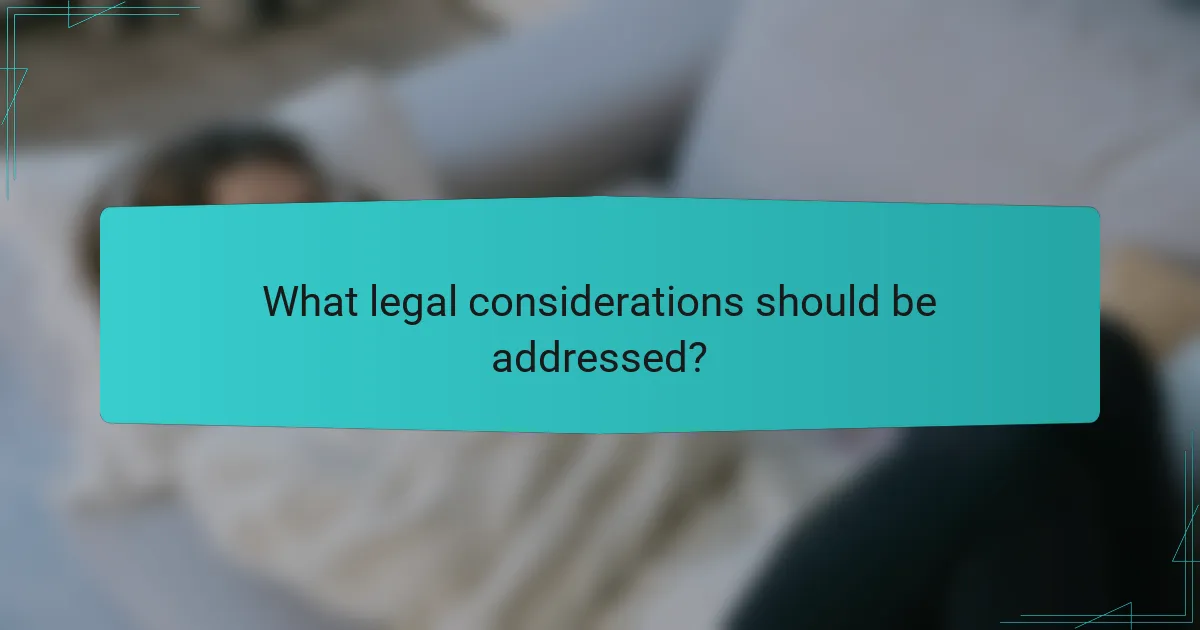Collaborative contracts represent a modern approach to agreements that prioritize cooperation and adaptability among stakeholders. By establishing clear communication, defining roles, and addressing legal considerations, these contracts enhance project outcomes and ensure that all parties’ interests are protected. Implementing best practices in this framework can lead to more successful project delivery and stronger partnerships.

What are the best practices for collaborative contracts?
Best practices for collaborative contracts include establishing clear communication, defining roles, and ensuring regular updates. These practices help streamline the agreement process and enhance cooperation among parties involved.
Clear communication guidelines
Effective communication is essential in collaborative contracts. Establishing guidelines for how and when parties will communicate can prevent misunderstandings and ensure that everyone is on the same page. Consider using regular check-ins or updates to facilitate ongoing dialogue.
Utilize various communication channels, such as emails, video calls, and collaborative platforms, to accommodate different preferences. Clearly outline expectations regarding response times and availability to enhance transparency.
Defined roles and responsibilities
Clearly defining roles and responsibilities is crucial for accountability in collaborative contracts. Each party should understand their specific duties and how they contribute to the overall agreement. This clarity helps prevent overlap and ensures that all necessary tasks are covered.
Consider creating a roles matrix that outlines each party’s responsibilities. This visual tool can help everyone stay aligned and focused on their commitments, reducing the risk of confusion or missed obligations.
Regular review and updates
Regularly reviewing and updating the collaborative contract is vital to adapt to changing circumstances. Schedule periodic reviews to assess the agreement’s effectiveness and make necessary adjustments. This practice ensures that the contract remains relevant and functional over time.
During these reviews, gather feedback from all parties involved. This collaborative approach can help identify potential issues early and foster a sense of ownership among participants, leading to a more successful partnership.
Utilizing digital collaboration tools
Digital collaboration tools can significantly enhance the efficiency of managing collaborative contracts. Tools such as project management software, shared document platforms, and communication apps streamline workflows and facilitate real-time collaboration.
Choose tools that are user-friendly and meet the specific needs of your team. Ensure that all parties are trained on how to use these tools effectively to maximize their benefits and minimize disruptions.
Conflict resolution mechanisms
In any collaborative contract, having clear conflict resolution mechanisms is essential. Establish procedures for addressing disputes early on to prevent escalation. This can include mediation, arbitration, or other agreed-upon methods for resolving disagreements.
Document these mechanisms within the contract to ensure that all parties are aware of the steps to take if conflicts arise. This proactive approach can help maintain a positive working relationship and ensure that issues are resolved efficiently.

How do collaborative contracts enhance project outcomes?
Collaborative contracts enhance project outcomes by fostering cooperation among stakeholders, allowing for more adaptable agreements. This approach leads to improved communication, shared goals, and ultimately, more successful project delivery.
Improved stakeholder engagement
Collaborative contracts promote active participation from all stakeholders, which can significantly enhance project alignment. By involving various parties in the decision-making process, these contracts ensure that diverse perspectives are considered, leading to more comprehensive solutions.
For example, regular workshops or meetings can be scheduled to gather input and feedback, ensuring that all voices are heard. This engagement not only builds trust but also encourages commitment to the project’s success.
Increased flexibility in negotiations
Flexibility is a key advantage of collaborative contracts, allowing parties to adapt terms as project needs evolve. This adaptability can help address unforeseen challenges without lengthy renegotiations.
For instance, if a project scope changes, stakeholders can quickly discuss and adjust deliverables or timelines, maintaining momentum. This approach contrasts with traditional contracts, which often require formal amendments that can slow progress.
Faster decision-making processes
Collaborative contracts streamline decision-making by establishing clear communication channels and predefined processes. With all stakeholders engaged, decisions can be made more efficiently, reducing delays.
Utilizing tools like consensus-building techniques or decision matrices can help expedite this process. By prioritizing collective input, teams can reach agreements swiftly, keeping projects on track and within budget.

What legal considerations should be addressed?
Legal considerations in collaborative contracts include compliance with local laws, intellectual property rights, and liability management. Addressing these factors ensures that agreements are enforceable and protect the interests of all parties involved.
Compliance with local laws
Ensuring compliance with local laws is crucial when drafting collaborative contracts. This includes understanding regulations specific to the jurisdiction where the contract will be enforced, such as labor laws, tax obligations, and industry-specific regulations.
For instance, a contract in the European Union must adhere to GDPR regulations regarding data protection. Failing to comply can result in penalties and invalidate the contract.
Intellectual property rights
Intellectual property (IP) rights must be clearly defined in collaborative contracts to protect the creations and innovations of all parties. This includes specifying ownership rights, usage rights, and any licensing agreements related to patents, trademarks, or copyrights.
For example, if two companies collaborate on a software project, the contract should outline who owns the code and how it can be used or modified in the future. Clear IP clauses help prevent disputes and ensure fair compensation for contributions.
Liability and risk management
Addressing liability and risk management is essential to minimize potential legal exposure in collaborative agreements. Parties should identify risks associated with the project and outline responsibilities in case of breaches or damages.
Including indemnification clauses can protect parties from losses caused by the other party’s actions. For example, if one party is responsible for a data breach, the contract should specify how they will compensate the affected party. This clarity helps manage expectations and reduces the likelihood of disputes.

What tools facilitate collaborative contract management?
Collaborative contract management relies on various tools that streamline processes, enhance communication, and ensure secure document handling. Key tools include electronic signature platforms, document storage solutions, and team communication applications, each serving distinct yet complementary roles in managing contracts effectively.
DocuSign for electronic signatures
DocuSign is a leading platform for obtaining electronic signatures, making it easier to finalize contracts quickly and securely. Users can send documents for signature via email or through the app, allowing signatories to review and sign from anywhere, reducing turnaround times significantly.
When using DocuSign, ensure that all parties are familiar with the platform to avoid delays. It’s also advisable to check compliance with local e-signature laws, such as the ESIGN Act in the U.S. or eIDAS in the EU, to ensure the validity of electronic signatures.
ContractWorks for document storage
ContractWorks provides a secure cloud-based solution for storing and managing contracts. This tool allows users to organize documents with tags and folders, making retrieval straightforward. Additionally, it offers features like automated alerts for key dates and deadlines, which helps in maintaining compliance and managing renewals.
Consider using ContractWorks if your organization handles a high volume of contracts. Its user-friendly interface and robust search capabilities can save time and reduce the risk of misplacing important documents. Always ensure that access permissions are set correctly to protect sensitive information.
Slack for team communication
Slack is an effective communication tool that facilitates collaboration among team members during the contract management process. It allows users to create channels for specific projects or contracts, enabling focused discussions and quick sharing of documents and updates.
To maximize Slack’s potential, integrate it with other tools like Google Drive or DocuSign for seamless workflows. Be mindful of maintaining clear communication protocols to prevent information overload and ensure that all team members are aligned on contract statuses and responsibilities.

What are the common challenges in collaborative contracts?
Collaborative contracts often face several challenges that can hinder their effectiveness. Key issues include misalignment of goals, inadequate stakeholder involvement, and technology adoption issues, each of which can complicate the collaborative process.
Misalignment of goals
Misalignment of goals occurs when parties involved in a collaborative contract have differing objectives or expectations. This can lead to conflicts and a lack of cohesion in decision-making. To mitigate this, all stakeholders should engage in thorough discussions to align their goals before finalizing the contract.
Regular check-ins throughout the contract’s lifecycle can help ensure that all parties remain aligned. Utilizing a shared vision statement can also serve as a guiding reference to keep everyone on track.
Inadequate stakeholder involvement
Inadequate stakeholder involvement can result in critical perspectives being overlooked, leading to incomplete or ineffective agreements. It is essential to identify and engage all relevant stakeholders early in the process to gather diverse insights and foster commitment.
To enhance involvement, consider creating a stakeholder map that outlines each party’s role and influence. Regular updates and feedback sessions can help maintain engagement and ensure that all voices are heard.
Technology adoption issues
Technology adoption issues can arise when stakeholders are not familiar with the tools or platforms used for collaboration. Resistance to change or lack of training can hinder effective communication and data sharing. Addressing these concerns early is crucial for smooth collaboration.
Providing comprehensive training sessions and ongoing support can facilitate technology adoption. Additionally, selecting user-friendly platforms that cater to the needs of all stakeholders can significantly reduce barriers to effective collaboration.

How can organizations measure the success of collaborative contracts?
Organizations can measure the success of collaborative contracts by assessing key performance indicators (KPIs) such as stakeholder satisfaction, cost savings, and the achievement of project goals. These metrics provide insight into how effectively the contract facilitates cooperation and delivers value.
Key Performance Indicators (KPIs)
Key Performance Indicators (KPIs) are essential for evaluating the effectiveness of collaborative contracts. Common KPIs include the timeliness of deliverables, budget adherence, and the quality of outcomes. Organizations should establish specific, measurable targets for each KPI to track progress over time.
For example, if a contract aims to reduce costs, a KPI could be a target of achieving savings of 10-15% compared to previous agreements. Regularly reviewing these metrics helps organizations identify areas for improvement and adjust strategies accordingly.
Stakeholder Feedback
Collecting feedback from stakeholders is crucial in measuring the success of collaborative contracts. Surveys and interviews can provide valuable insights into how well the contract meets the needs of all parties involved. This feedback can highlight strengths and weaknesses in the collaboration process.
For instance, if stakeholders report dissatisfaction with communication, organizations can implement strategies to enhance transparency and information sharing. Regular feedback loops can foster a culture of continuous improvement.
Cost Savings and Efficiency
Cost savings and efficiency are critical indicators of successful collaborative contracts. Organizations should analyze financial data to determine if the contract has led to reduced expenses or improved resource utilization. Tracking these metrics helps justify the investment in collaborative approaches.
In practice, organizations might find that collaborative contracts lead to savings of 5-20% on project costs due to shared resources and streamlined processes. Monitoring these financial outcomes can guide future contract negotiations and partnerships.
Achievement of Project Goals
The achievement of project goals is a fundamental measure of success for collaborative contracts. Organizations should define clear objectives at the outset and assess whether these goals are met within the specified timeframe. This evaluation can include both qualitative and quantitative measures.
For example, if a contract’s goal is to complete a project within six months, organizations should track progress against this timeline. Regular milestone reviews can help ensure that all parties stay aligned and accountable throughout the project lifecycle.



